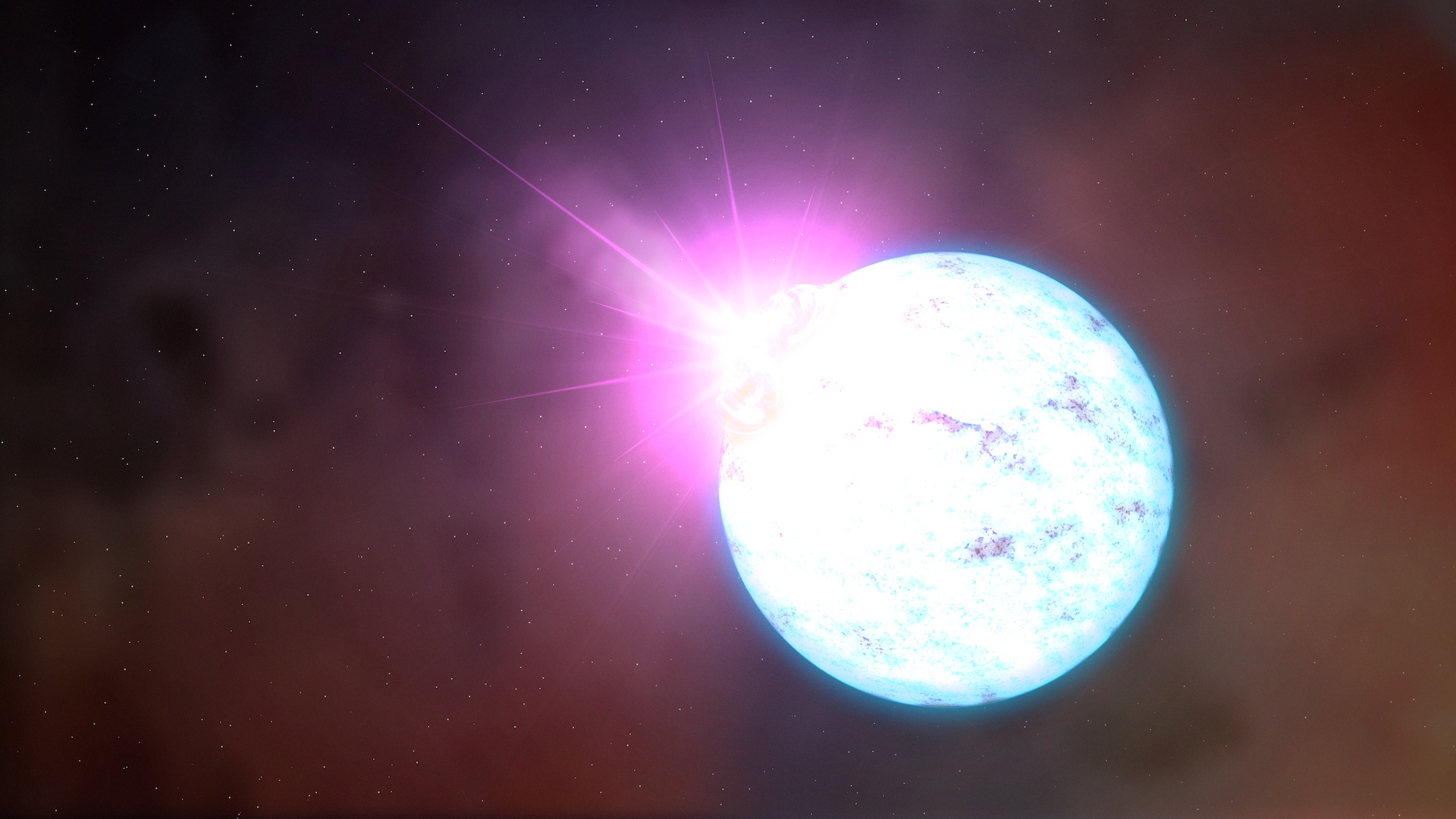Supermagnetic Stars May Form from Mergers

The most magnetic stars may have their origins in merging stars, a new study finds.
When it comes to relatively massive stars — ones more than 1.5 times the mass of the sun — previous research found that about 10% have strong magnetic fields that are on average 100 to 1,000 times stronger than the sun's. Other prior work has suggested that merged stars — ones resulting from the fusion of two other stars — could generate powerful magnetic fields, and that 10% of massive stars are predicted to result from mergers.
One reason merged stars are expected to possess strong magnetic fields is because, as one might expect, when two stars collide into one another, the result is a great deal of turbulence. Merged stars inherit such turbulence, and such "turbulent energy is converted into magnetic energy," said study lead author Fabian Schneider, an astrophysicist at the University of Heidelberg in Germany.
Related: How to Tell Star Types Apart (Infographic)
(A star or planet's magnetic field is powered by what's called its dynamo, which results from the swirling motion of an electrically conducting fluid. In the case of Earth, this fluid is molten iron within the planet's core; in the case of stars, this fluid is plasma, or clouds of electrically charged particles.)
To see if merged stars actually might generate powerful magnetic fields after they settled down following the fusing together of their parent stars, Scheider and his colleagues developed 3D computer simulations of mergers between pairs of massive stars that were not magnetic and followed how the results evolved over time. Specifically, they analyzed mergers that were expected to result in merged stars, with each fused pair having 17 times the sun's mass, similar to the magnetic star Tau Scorpii, located about 470 light-years from Earth in the constellation Scorpius.
The simulations found that after merged stars settled back into an equilibrium state following the tumult of the mergers that created them, "strong magnetic fields are indeed produced," Schneider told Space.com.
Get the Space.com Newsletter
Breaking space news, the latest updates on rocket launches, skywatching events and more!
The researchers also found the infusions of fuel that merged stars inherited from their parents made them appear hotter than stars of the same age, and thus younger and bluer. This could explain the strange properties of Tau Scorpii, which is a so-called "blue straggler," an oddball star that seems to be younger in age than its ancient neighbors, even though all of the stars in the region presumably formed at the same time. Specifically, blue stragglers appear inexplicably hot, young and blue compared with their brethren, and previous research suggested that blue stragglers may at times result from one star swallowing another star, which is how a merger happens.
In addition, the researchers suggested their findings might shed light on the genesis of magnetars, the strongest magnets in the cosmos. Magnetars are a rare type of neutron star. (A neutron star is the core of a massive star that devoured all its fuel, collapsed under its own weight and then exploded as a supernova.) Magnetars can possess magnetic fields up to approximately 5,000 trillion times that of the Earth's.
The scientists found that when the kind of massive magnetic star created in the new study's computer simulations collapsed to form a neutron star, it might have a magnetic field as powerful as that of a magnetar. They also noted that previous research suggested about 15% of the kind of supernova that creates neutron stars produce a magnetar. This is consistent with how 10% of all massive stars possess magnetic fields, thus lending support to the new study’s suggestion that magnetars are potentially born from the collapse of massive magnetic stars.
"Our mechanism of merging then appears to be a promising way to also explain why some neutron stars may have so incredibly strong magnetic fields, supposedly the strongest in the whole universe," Schneider said.
In the future, the scientists plan to examine mergers of other kinds of massive stars to see if they also produce magnetic stars, Schneider said. They also want to see how long the magnetic fields of these merged stars actually last.
"We still cannot say for how long the field will exist," Schneider said. "At the moment, everything points in the direction that it will last for the lifetime of the star, and maybe even longer. Tackling this issue is challenging, but we will hopefully find a way."
The scientists detailed their findings online Oct. 9 in the journal Nature.
- Know Your Novas: Star Explosions Explained (Infographic)
- Inside a Neutron Star (Infographic)
- Death of a Sunlike Star: How It Will Destroy Earth (Infographic)
Follow Charles Q. Choi on Twitter @cqchoi. Follow us on Twitter @Spacedotcom and on Facebook.
Join our Space Forums to keep talking space on the latest missions, night sky and more! And if you have a news tip, correction or comment, let us know at: community@space.com.

Charles Q. Choi is a contributing writer for Space.com and Live Science. He covers all things human origins and astronomy as well as physics, animals and general science topics. Charles has a Master of Arts degree from the University of Missouri-Columbia, School of Journalism and a Bachelor of Arts degree from the University of South Florida. Charles has visited every continent on Earth, drinking rancid yak butter tea in Lhasa, snorkeling with sea lions in the Galapagos and even climbing an iceberg in Antarctica. Visit him at http://www.sciwriter.us









